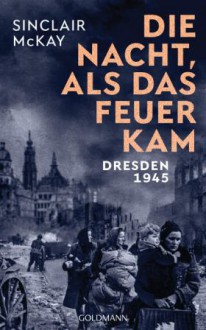
Inhaltsangabe
In der Endphase des Zweiten Weltkrieges, im Februar 1945, bombardierten die Alliierten Dresden: Circa 25.000 Menschen fanden den Tod, die Überlebenden waren zutiefst traumatisiert, das einst prächtige Elbflorenz lag in Schutt und Asche. In »Die Nacht, als das Feuer kam« begibt sich der britische Journalist und Autor Sinclair McKay auf eine ganz besondere Spurensuche. In den Archiven der Stadt entdeckte er tief verborgene persönliche Aufzeichnungen, die es ihm ermöglichen, die Geschehnisse dieser drei verhängnisvollen Tage und Nächte aus der Perspektive der Bewohner der Stadt zu erzählen: Schülern, Mitgliedern der Hitlerjugend und des Kreuzchors, Künstlern, Musikern, aber auch des Kriegsgefangenen Kurt Vonnegut und nicht zuletzt Victor Klemperer sowie Piloten und Besatzungsmitgliedern der britischen und amerikanischen Verbände. Noch nie zuvor wurde das Ausmaß dieses Luftangriffs für die Zivilbevölkerung der Stadt so vielstimmig, emotional und zutiefst menschlich geschildert wie in diesem Meisterwerk der narrativen Geschichtsschreibung – und das noch lange, nachdem die letzte Seite umgeblättert ist, im Gedächtnis bleiben wird.
Meine Meinung
Von diesem verheerenden Bombenangriff haben wir wohl alle schon mal im Geschichtsunterricht gehört. Inzwischen sind 75 Jahre vergangen und dieses Buch kann immer noch den ganzen Schrecken dieser Nacht darstellen.
Dieses Werk baut sich aus drei Teilen auf.
Teil 1 – Die Katastrophe rückt näher
In diesem ersten Abschnitt spürt man zunächst die nahende Gefahr und bekommt viele allgemeine Informationen rund um diese Thematik.
Der Autor geht vorab darauf ein, warum gerade das „Schmuckstück“ Dresden zum Ziel wurde. Die sächsische Stadt spielte eine wichtige Rolle im damals noch bestehenden Zweiten Weltkrieg, aber Dresden hatte auch in den Bereichen Kunst, Wissenschaft und Architektur einen hohen Stellenwert.
In diesem einleitenden Teil fielen so einige Namen. Manche sagten mir etwas, andere eher weniger, aber den bin ich gerne nachgegangen.
Darunter zum Beispiel:
Otto Griebel, Otto Dix , Caspar David Friedrich (dt. Maler)
Richard Wagner und Richard Strauss (dt. Komponisten)
Heinrich Barkhausen (dt. Physiker)
Martin Mutschmann (Politiker in der NSDAP)
Henry Schmidt (SS-Untersturmführer)
Miles Tripp und Kurt Vonnegut (schrieben ein Buch über ihre Erfahrungen)
Teil 2 – Die Schreckensnacht
„In dieser Nacht starteten siebenhundertsechsundneunzig Lancaster und Mosquitos mit etwa fünftausendfünfhundert Mann Besatzung, um Dresden in zwei großen Wellen zu bombardieren.“ (S. 245)
„Achtung, Achtung! Starke anglo-amerikanische Bomberverbände im Anflug auf Dresden! Entfernung circa zwanzig Kilometer! Suchen Sie die Luftschutzräume auf!“ (S. 259, Radiodurchsage)
Diese Information war für mich tatsächlich neu. Beim Lesen aber ahnte und spürte ich es tatsächlich schon. Nachdem die ersten Bomben gefallen waren und die Bewohner der Stadt in ihren Kellern oder öffentlichen Bunkern Schutz suchten, war der Schrecken noch nicht vorbei. Diese Darstellung der erneuten Bombardierung, nachdem die ersten Anwohner ihren Schutz bereits verlassen hatten, um nach ihren Familienangehörigen zu suchen, fand ich grandios.
Des Weiteren eine interessante Information war, dass der 13. Februar 1945 der Faschingsdienstag war. Die Menschen feierten an diesem Tag.
Schlimm, dass die Menschen diesen feierlichen Anlass wohl immer mit diesem Ereignis verbunden haben.
Es werden viele Eindrücke und Empfindungen der Dresdner veröffentlicht, darunter „Nach einer scheinbar endlosen Zeit wurde endlich die Tür des Kellers geöffnet. Niemand konnte fassen, was ihn draußen erwartet! Die Stadt brannte lichterloh, und es war so heiß, einfach unvorstellbar.“ (S. 300)
Der Autor bringt in diesem Abschnitt sowohl sehr viele Zeugenaussagen ein, von Menschen, welche dieses Ereignis am eigenen Leib erlebt haben.
Aber als Leser bekommt man auch einen Einblick in die Gedanken- und Gefühlswelt der Bomberflieger.
„Für die Flieger war der Einsatz nur eine weitere furchterregende Nacht, und Dresden war nur ein weiteres Ziel.“ (S. 276f.)
Der Schrecken dieser Nacht waren die Toten, die völlig verbrannt auf den Straßen der Stadt ihr Leben ließen und zum Teil niemals identifiziert werden konnten. Die vielen Anwohner, die ihren Wohnsitz und alles Hab und Gut verloren haben. Oder auch die Bewohner, welche starke gesundheitliche Beeinträchtigungen davon getragen haben, vor allem die Organe Augen und Haut waren sehr oft betroffen.
Teil 3 – Das Nachbeben
Wie schon der erste Teil beinhaltet auch der dritte Teil eine Reihe von Bildern und Fotografien, welche dem Leser nochmal vor Augen führen, wie Dresden damals „dastand“. Für mich perfekt ausgewähltes Bildmaterial.
Weiterhin beschreibt der Autor sehr ausführlich, wie sich der Wiederaufbau Dresdens unter russischem Einfluss gestaltete. Dieser Aspekt ist ebenso wichtig zu wissen, wies für mich aber auch einige Längen beim Lesen auf.
Mein Fazit
Ein Werk, welches man als Gesamtwerk zum Thema „Bombardierung auf Dresden“ bezeichnen kann. Der Autor recherchierte ausführlich zur Thematik und belichtete diesen verändernden Tag von vielerlei Hinsicht.
„Die Nacht, als das Feuer kam“ stellt ein Sachbuch dar, welches einige trockene Seiten aufweist. Mich im Großen und Ganzen trotzdem beeindrucken konnte.


 Log in with Facebook
Log in with Facebook 









